home | metro santa cruz index | features | santa cruz | feature story
Health Issue:
Walking | Kofi Busia
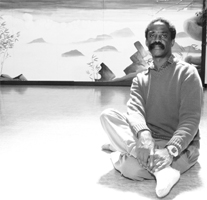
Photographs by Felipe Buitrago
Master and student: Once a student of Iyengar, Kofi Busia now translates the teachings of the master to his own students.
The Method Man
In yoga teacher Kofi Busia, Santa Cruz has a direct line to the carefully codified teachings of B.K.S. Iyengar
By Denise Vivar
'Reach and lengthen, feel your left leg lengthening as you continue to stretch your arms forward," commands our instructor in a British-inflected lilt.
Strolling around the studio, he aligns a hip here, pushes down a shoulder there, and continues to lead us through the rigors of Virabhadrasana III, or warrior pose: right leg planted on the floor, body bent forward with the arms reaching out in front, left leg lifted in a straight plane behind.
"Remember to be graceful, remember you are poised," he continues in a meditative cadence.
The ceiling fans whir above us. The air is humid with the exertions of some 50 bodies reaching and lengthening and generally pushing physical limits. We are warm with the strain of our efforts. Kofi Busia, our teacher, meanders about in shirtsleeves and trousers.
"Hold yourself straight and beautiful, as if you are posing for a statue to be erected in your very county to commemorate your perfect poise."
He doesn't break the rhythm of his meter, but his droll remark causes me to chuckle and lose what "poise" I had mustered. Model yogini I am not, I muse as I struggle to regain the posture and clear the imagery of Virabhadrasana in bronze in the lobby of the county building from my head.
Kofi Busia is a teachers' teacher, and here at the Yoga Center in this intermediate class it is clear that he is very popular among the more accomplished practitioners in Santa Cruz. Busia is a teacher of the Iyengar style of yoga, the yoga of precision and exacting technique. He learned it from the source, B.K.S. Iyengar himself, over the course of more than a decade of study. Busia's forthcoming book, Iyengar The Yoga Master, is a compilation of essays on his teacher.
This month, at the Yogacharya Festival and Conference in Santa Clara honoring Iyengar, Busia will be joined by dozens of fellow adherents and some of his own well-known students, including Rodney Yee of video yoga fame. For Busia, it will be a rare chance to immerse himself in the company of others who have dedicated their lives to the man they call "Guruji."
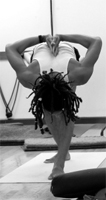
Now do the twist: Students of Iyengar learn proper technique and alignment.
The Search
If you ask Busia how he came to study yoga he'll reply that what ultimately set him on his path was the game of badminton. Evidently the road to a yogic life is sometimes lined with shuttlecocks.
"While I was a student at Oxford University I was quite the badminton player," he says, and while he enjoyed the sport he found many of the other players far too serious about the game. "I was, after all, in it for the fun."
So while the other guys were jostling for precious court time, Busia found himself teaching beginners--an unsatisfying post for an accomplished player like himself. Lacking a challenge, his attention wandered. The door was opened. A friend invited Busia to give yoga a try, and in short order it was "bye-bye, birdie."
While the physicality of yoga was satisfying to him, Busia says it was more than the asanas (poses) that kept him interested. He describes himself at the time as "a young man looking for something."
"I was a very religiously inclined fellow," Busia says. "My father was a devout Methodist and mother a devoted Anglican. I was concerned about what would happen to me after I died, and I knew that if you have the right faith you didn't concern yourself with such things. I thought God would see my concern and know that I was not sure about my faith. I was psychologically grasping."
In his teacher Penny, Busia detected "something deeper than the physical postures" and wondered if he might find the answer to what he sought in yoga.
That was 37 years ago. After a year, Penny introduced him to her own teacher, B.K.S. Iyengar. By that time Iyengar had published his first book of teachings, Light on Yoga, and was already well known in the West. Penny asked Busia to attend one of Iyengar's classes, and in that first session asked Iyengar to take on Busia as a student. Iyengar would come to England to teach an eight-week intensive each summer and Busia would study with him then.
In 1975, Iyengar opened the Ramamani Iyengar Memorial Yoga Institute in Pune, named after his wife, and Busia began his travels to India. There he continued under the master's direct tutelage for more than 10 years.
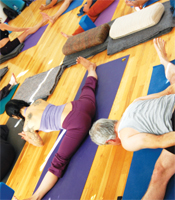
Forward thinking: Strength, flexibility and balance are the reward for keeping your head down and toes up.
The Source
At 88 years old, Yogacharya Sri B.K.S. Iyengar is in his 70th year of teaching yoga. His form, known as Iyengar Yoga, is the most well-known and practiced style of yoga in the world today, and he is the guru to many of the world's leading yoga teachers.
Iyengar's calling came in 1936, when after only two years of practice he was offered up as a teacher by his guru, Sri T. Krishnamacharya. He was sent to Pune, in the Indian state of Maharashtra, where a yoga school was in need of an instructor who could speak English.
At the time, what Iyengar knew about yoga was that it is a healing practice, that if one properly held certain poses one could fully integrate the body, mind and spirit. What he subsequently learned was that he had a gift to share with his students: a clear and direct explanation of how to achieve each pose.
Yoga can be defined as "union of the human soul with the supreme being." There are six yoga systems, which are practiced through asanas, breathing, devotional worship, scriptural study, meditation, chanting and service.
Several styles of yoga have achieved some prominence throughout the United States. Hatha encompasses the physical forms of practice, which aim to balance the mind, body and spirit through the asanas. Ashtanga is a physically demanding style (this is Madonna's yoga) with a defined set of poses done in a certain order, combined with a focus on breathing and flow of postures with the intention to build strength and stamina. Bikram ("hot yoga") is characterized by a defined number of poses done in exact sequence in a room heated to 100 degrees in order to warm muscles and promote detoxification.
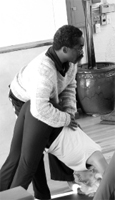
Pressing business: Busia corrects a student's form in Downward Facing Dog.
And then there's Iyengar, with its attention to precision, alignment and repetition. Poses are sustained and aided by various props such as belts, blocks, sandbags and pillows, to reportedly salubrious effect.
"When other schools of yoga talk about therapeutic yoga they talk about Iyengar," Busia says.
What makes Iyengar one of the most widely practiced forms of yoga, according to Busia, is not only its success as a therapeutic practice but its ability to be precisely passed from one teacher to the next. Because Iyengar so effectively designed a systematic approach to proper body alignment, the integrity of the teachings is maintained through each concession.
"You are not trying to pass on something subjective like "a sense of feeling good," Busia says. "How would you distinguish feeling good from laziness? You cannot teach transformational moments. With Iyengar's teachings you don't have to meet him to get his message, so it is accessible to everyone."
When asked if he has explored any other styles of yoga, Busia says no. "I never considered any other form. I found my guru and didn't need to look elsewhere."
By way of an explanation he illustrates a scenario using Dante and Shakespeare as examples.
"At one time it was believed that literature of any import should be written in Latin. Dante and Shakespeare revolutionized literature in their day because they decided that they had something to say and a perfectly good language--their respective native tongues--in which to say it. A teacher is simply someone who has something to express and has found a way to express it. Other people, followers and students, turn these expressions into a method."
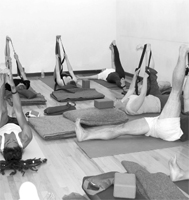
Shake a leg: The Iyengar style encourages the use of ties, blocks and other aids--whatever it takes to get the asana right.
The Call to Teach
Busia the student soon turned teacher as well, and it has been 35 years since his first teaching experience. His own student roster is an impressive list of yoga masters, among them Rodney Yee, Patricia Walden and John Friend. But while he is a teachers' teacher, Busia still enjoys instructing beginners and holds classes and intensive workshops at all levels. Additionally, he has been putting the finishing touches on two books, a translation of the original Sanskrit Yoga Sutras of Patañjali (Patañjali is considered to be the founder of yoga) and Iyengar The Yoga Master, to be released on July 24.
Iyengar The Yoga Master is a celebration of the man many refer to as their guru, or Guruji. With a compilation of some 50 essays, interviews and stories by yoga masters as well as students, the book is a comprehensive exploration of yoga, the philosophy and the physical aspects, and the man who has helped make "yoga" a household word in the West. Busia's close connection with both the master and many of his students makes him the natural collaborator for this project as well as for the yoga festival he is producing in the coming week.
The Yogacharya (meaning "yoga teacher") Festival is an event dedicated to honoring the life and work of Iyengar. In this gathering, dozens of instructors from around the world are coming together to share their knowledge and spirit with participants in the name of B.K.S. Iyengar. "So many people are so graciously giving of their time for this event, and are happy to have a public format to thank Guruji for his teachings," Busia says.
Proceeds from both the book and the festival will go to the Bellur Charitable Trust, created by Iyengar to serve the rural community of Bellur, the village of his birth.
When I ask Busia if he, the yoga teacher, is still a yoga student, he searches for an analogy and answers in the interrogatory.
"Have you ever suffered a broken heart? And when your child suffers a broken heart would you not also experience it? Would any of those instances be the same and would you even be able to tell him about broken hearts?
"Yoga is about consciousness. If I am in the moment and paying attention I can ask myself, 'What am I trying to express in this moment?' Then your practice is integrated with your everyday life, and life is a constant teacher."
For more information about the Yogacharya Festival, July 9-15, visit www.yogacharya.org. Kofi Busia will sign copies of his new book, 'Iyengar The Yoga Master,' at Gateways Books, 1126 Soquel Ave., Santa Cruz, on Thursday, Aug. 30, at 7pm.
Send a letter to the editor about this story.
|
|
|
|
|
|